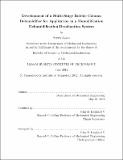Development of a multi-stage bubble column dehumidifier for application in a hymidification dehumidification desalination system
Author(s)
Lam, Steven, S.B. Massachusetts Institute of Technology
DownloadFull printable version (20.23Mb)
Other Contributors
Massachusetts Institute of Technology. Dept. of Mechanical Engineering.
Advisor
John H. Lienhard V.
Terms of use
Metadata
Show full item recordAbstract
The Center for Clean Water and Clean Energy at MIT and KFUPM have been developing many novel desalination systems. One of the new technologies originating from the Lienhard Research Laboratory is the Humidification Dehumidification desalination system, or HDH. In many ways HDH resembles the natural rain cycle for producing fresh water, in that sea water is evaporated from oceans into humid air that travels up into the atmosphere, before condensing and producing precipitation. That precipitation is then collected as fresh drinking water. One of the main hindrances with carrier gas based desalination systems over traditional thermal desalination systems like multi-flash distillation (MSF) systems is that there is a large thermal resistance in the dehumidifier between the carrier gas and the condensing coils resulting in poor heat transfer rates. The proposed solution is to create a bubble column for improved condensation. The condensing coil will be submerged in a body of water while humid air is sent through a sieve plate to create bubbles in this body of water where it will condense directly. Firstly, a single stage bubble column was designed, built, modeled, and tested. The model theoretically predicts the effects of bubble diameter, superficial velocity, liquid height in column, inlet mole fraction of vapor, impact on coils, and particle integration. Through experimentation it was shown that it was possible to achieve heat transfer rates of of 4 kW1m2 up to 20 kW1m2 ; rates that are 10 to 30 times that of existing state-of-the-art dehumidifiers. Secondly, a multi stage bubble column was designed, built, modeled, and tested in a full HDH system. Multi-staging is done to improve the effectiveness of the system. A three stage column was able to achieve an effectiveness of 89.4%.
Description
Thesis (S.B.)--Massachusetts Institute of Technology, Dept. of Mechanical Engineering, 2012. This electronic version was submitted by the student author. The certified thesis is available in the Institute Archives and Special Collections. Cataloged from student submitted PDF version of thesis. Includes bibliographical references (p. 67).
Date issued
2012Department
Massachusetts Institute of Technology. Department of Mechanical EngineeringPublisher
Massachusetts Institute of Technology
Keywords
Mechanical Engineering.